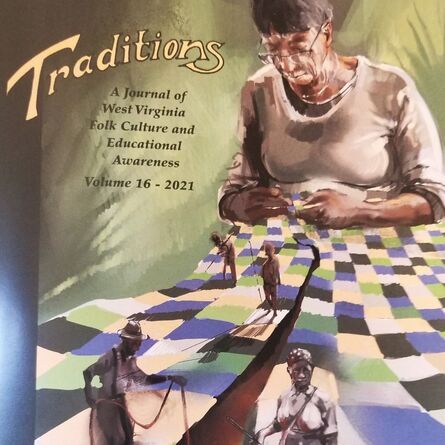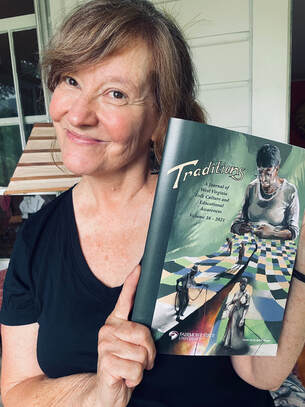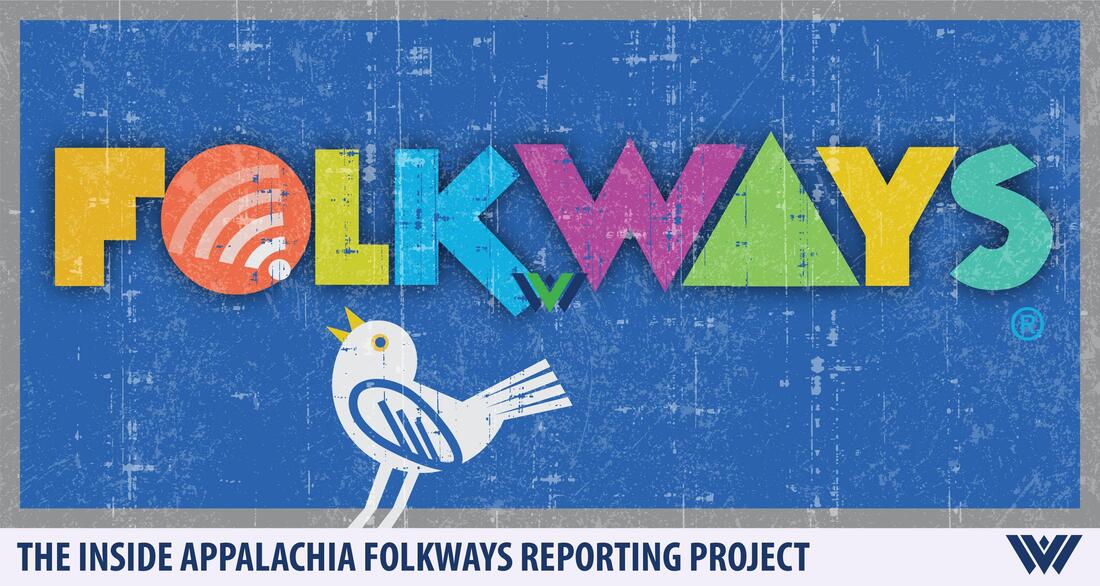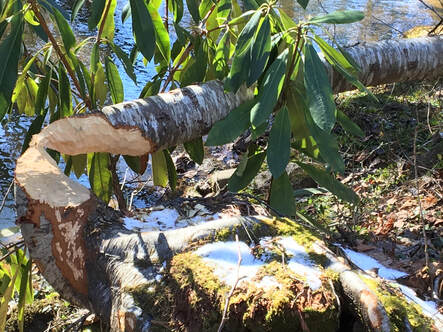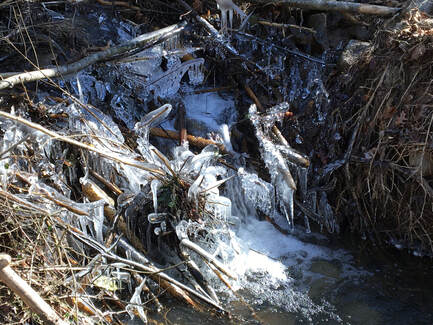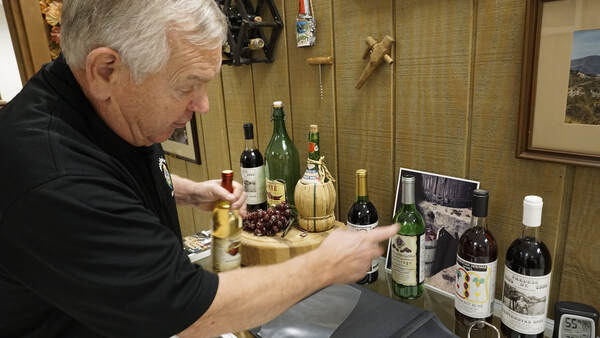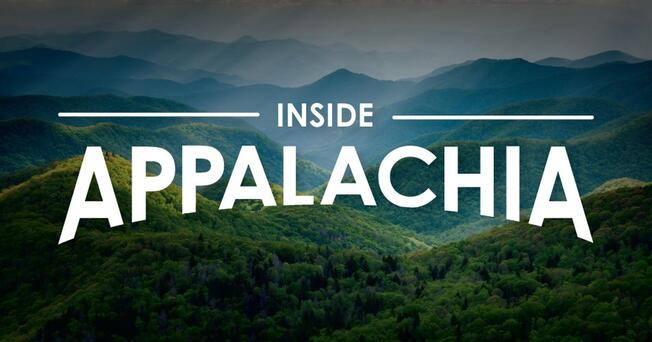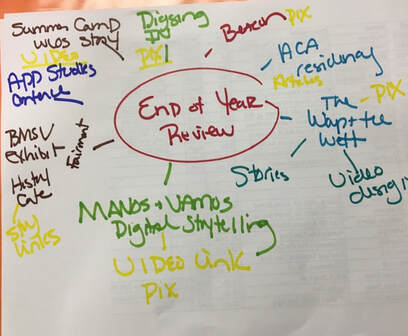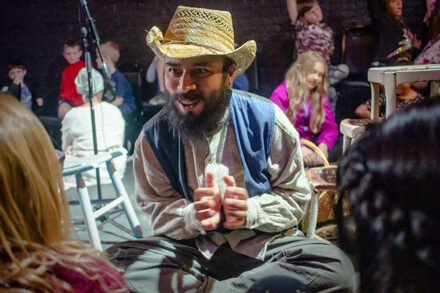|
I am delighted that my work as an author is included in the 16th volume of Traditions: A Journal of West Virginia Folk Culture and Educational Awareness and published by The Frank & Jane Gabor West Virginia Folklife Center. The article, "Old Fashioned Communism and Cultural Diversity in Appalachia," explores race, class and gender in the textile industry of North Carolina. This edition of Traditions examines diversity in West Virginia and beyond, prompted by the Center's Diversity in Appalachia Lecture Series in 2018-2019, where I was invited as a guest lecturer to discuss the role of gender and race in the textile industry. The Folklife Center decided to bring a series of speakers on campus to complicate the conversation about that year's choice of Hillbilly Elegy as the "common read" for students. Since my initial presentation our nation has weathered a deadly pandemic, ongoing protests against police brutality and systemic racism, a highly divisive presidential election, and an insurrection at the U.S. capital. Oh and Hillbilly Elegy was made into a movie. In these life changing times, I am thrilled to be a part of the conversation that complicates the role of Appalachian identity and encourages us to question assumptions and stereotypes of the past. If you would like a copy of this issue of Traditions please call the Folklife Center at 304-367-4403 or email wvfolklife@fairmontstate.edu Suggested donation is $10 per copy
0 Comments
New Storytellers Join Inside Appalachia Folkways Reporting CorpsWest Virginia Public BroadcastingPublished March 26, 2021 at 12:49 PM EDT This is the third year of WVPB's special Inside Appalachia project, which is designed to shine a light on the arts and culture of a six-state region of Appalachia, including Virginia, Kentucky, Tennessee, North Carolina, West Virginia and Ohio.Four new journalists, folklorists and a chief editor have joined the Inside Appalachia Folkways Reporting Corps to bring the West Virginia Public Broadcasting audience even more fascinating stories that explore the region’s rich cultural heritage. This is the third year of the special Inside Appalachia project, which is designed to shine a light on the arts and culture of a six-state region of Appalachia, including Virginia, Kentucky, Tennessee, North Carolina, West Virginia and Ohio. Thirteen specialized storytellers are focused exclusively on Appalachian art, crafts, music, dance and foodways. Their Folkways stories will air as a part of Inside Appalachia's weekly radio show on WVPB Sundays at 7 a.m. and 6 p.m. It is also available as a podcast on wvpublic.org and can be heard on a number of partner stations. Joining the Inside Appalachia Folkways Reporting Corps from across central Appalachia are Laura Harbert Allen of Charleston, West Virginia; Heather Duncan of Knoxville, Tennessee; Lauren Griffin of Morgantown, West Virginia; and David Wooldridge of Lowesville, Virginia. Returning to the corps from last year are Connie Bailey-Kitts of Bluefield, Virginia; Clara Haizlett of Bethany, West Virginia; Trevor McKenzie of Boone, North Carolina; Rachel Greene Moore of Boston, Massachusetts; Katie Myers of East Kentucky and East Tennessee; Heather Niday of Green Bank, West Virginia; and Rebecca Williams of Swannanoa, North Carolina. Zack Harold of Ashford, West Virginia, and Nicole Musgrave of Whitesburg, Kentucky, are returning as part-time Folkways staff reporters for the project. Inside Appalachia producer Roxy Todd said she is looking forward to seeing so many talented reporters eager to return this year to deepen their folkways reporting skills. "After nearly three years, folks are getting into the groove of what this project is, and there’s a real hunger among team members to focus on sharing stories that break stereotypes about Appalachia. I expect to hear unique stories that really go beneath the surface." New corps members include: Laura Harbert Allen of Charleston, West Virginia. She is an experienced audio storyteller who has contributed to and produced work for podcasts such as Making Contact, Us & Them, Freakonomics Radio and Inside Appalachia. She also has public media leadership experience as a program director and general manager at WEKU-FM near Lexington, Kentucky. She hopes to finish her Ph.D. in media studies at the Scripps College of Communication at Ohio University this year. She teaches podcasting and audio storytelling at OU and says she loves teaching and learning from the next generation of audio storytellers. Heather Duncan of Knoxville, Tennessee. She is an award-winning reporter, book editor and oral storyteller who hails originally from the mountains of North Carolina. She has 20 years’ experience reporting and writing local and regional news for daily newspapers, alternative weeklies, radio and online outlets. She spent years focused on covering the environment and sense of place and contributed to the Pulitzer-Prize winning coverage of Hurricane Katrina for The Biloxi Herald. She lets off steam by playing the clarinet and telling historical stories and folktales at local schools. Lauren Griffin of Morgantown, West Virginia. She grew up in Wheeling and graduated from West Virginia University in 2019. She splits her time fundraising for Preston County Parks and Recreation and serves as an AmeriCorps member with the West Virginia Association of Museums. She enjoys traveling, cross-stitching and exploring the heritage and landscape that makes up her home. David Wooldridge of Lowesville, Virginia. He began working at Appomattox Court House National Historical Park in 1995 where he now serves as the park’s Museum Technician. At the National Park, he works a stone’s throw away from the Mariah Wright house, the ancestral home of his third great-grandmother, restored and preserved by the National Park Service. Wooldridge, a former middle and high school social studies teacher and administrator, received his bachelor’s degree in history and education from Radford University and his master’s degree from the Curry School at the University of Virginia. He has played and studied the early banjo for over 25 years. He is passionate about telling untold stories. Returning corps members include: Connie Bailey-Kitts of Bluefield, Virginia. She grew up with a story-telling veterinarian father who shaped her path in journalism. She graduated from Iowa State University with a degree in journalism and worked there as a science writer before returning home for a life-altering period as a caregiver. Coming home also meant rediscovering a new appreciation for Appalachia. She’s written about its people, places and problems while reporting for a weekly newspaper, has recently fallen in love with radio and continues to freelance writing and editing. She enjoys raising dairy goats, making movies about them, and foraging for greens. As an Airbnb host, she's been fortunate to hear stories from all over the world. Clara Haizlett of Bethany, West Virginia. She is a multimedia storyteller inspired by folklife, cross-cultural dialogue and the natural world. She stumbled upon the world of storytelling somewhat accidentally. During her final year at West Virginia University, she started a podcast as a fun "side project." But from the very beginning, it was clear that podcasting would not be a "side project." She was hooked, entirely spellbound by the art of storytelling. Since then, she's shifted her career to journalism, producing work for outlets like PBS, Smithsonian Folklife, and Virginia Public Media. Trevor McKenzie of Boone, North Carolina. He works with manuscripts, field recordings, and other materials detailing Appalachian history and life in the W.L. Eury Appalachian Collection at Appalachian State University. On nights and weekends, he performs traditional music at square dances and concerts both as a solo artist and with string bands. Rachel Greene Moore of Boston, Massachusetts. A native of Western North Carolina, she is a freelance journalist who has covered environmental issues and folkways throughout Appalachia and the South. In her spare time, Rachel enjoys collecting oral histories, baking and hiking. Katie Myers of East Kentucky/East Tennessee. She is a writer, environmental educator and amateur water scientist who splits her time living in both East Kentucky and East Tennessee. In addition to her reporting for the Inside Appalachia Folkways Corps, she’s a reporter with the Ohio Valley ReSource and WMMT Mountain Community Radio out of Whitesburg, Kentucky. She's covered southern politics, social movements and environmental justice issues with Scalawag, Science for the People, Current Affairs, Commune Magazine and others. She is a recipient of the Kristi Havens Fellowship through Sundress Academy for the Arts. Heather Niday of Green Bank, West Virginia. She began as a volunteer deejay for Allegheny Mountain Radio in 1998 alongside her husband Chuck, who is the chief engineer for AMR. She joined the AMR staff in 2007 as news director and became the program director in 2013, later adding traffic manager to her many roles. She grew up in the Richmond, Virginia, area. She moved to Green Bank when her husband began working at the Green Bank Observatory. She is a long-time musician (flute and vocal), choir director for Arbovale UMC and Steering Committee member of the Mountain Music Trail. She co-hosts Something Different, a weekly jazz show on AMR. Rebecca Williams of Swannanoa, North Carolina. She is a writer, director, educator and digital media storyteller who has facilitated community-based arts and cultural development projects for the past 25 years in Virginia, Florida, Kentucky, Oklahoma and North Carolina. Along with her husband, Jerald Pope, she co-founded Serpent Child Productions, a nonprofit dedicated to the collaborative creation of multidisciplinary art that draws on the history and stories of community participants. She is a graduate of Duke University’s Center for Documentary Studies. Returning part-time Folkways Corps members include: Zack Harold of Ashford, West Virginia. He is a southern West Virginia native, the grandson of two coal miners, the son of a Pentecostal preacher, a former staff writer with The Charleston Daily Mail and former managing editor of WV Living and Wonderful West Virginia magazines. He currently works with the WVU Extension Service Family Nutrition Program. He enjoys playing music with his band, The Sycomores. Nicole Musgrave of Whitesburg, Kentucky. She is an independent folklorist and media producer. Recently, she’s worked with Appalshop and Partners for Education at Berea College to document eastern Kentuckians’ experiences during the COVID-19 pandemic. She has an M.A. in Folk Studies from Western Kentucky University. Meet our new chief folkways editor: Chris Julin, an award-winning reporter, editor and producer, joined the team earlier this year as its chief folkways editor. He is a seasoned production professional who has made audio stories "since the days of typewriters and cassette tapes." He’s been a reporter, producer and editor at Minnesota Public Radio, among other public radio stations. In recent years, he's helped launch and worked behind the scenes of many podcasts, including WVPB’s Us & Them. He also edits and produces radio documentaries and feature stories, and he teaches journalism at the college level. The projects he’s been affiliated with have won a variety of awards, including the Edward R. Murrow Award and the Peabody Award. TagsTop StoriesFolkwaysInside Appalachia Folkways Project  Maybe it’s a hangover from celebrating Imbolc earlier this week and the lengthening of the days. Maybe it’s those crazy daffodil shoots that are poking up through the ground, pushing through the hard soil with its light dusting of snow. Maybe it’s the incessant ringing of the wind chimes that hang on the deck, but something is stirring. This afternoon I got off my fourth Zoom workshop of the week- which sounds like more of a drag than it was- especially since this one was small enough to be interactive. We had breakout groups which allowed me to have a real conversation with another human being I didn’t know, as if we were sitting next together in a room. Remember that? Heaven. Each of the things I have signed up for this week have fed a different part of me. A song circle with Saro Lynch, where we silenced our mics and taught one another songs and experimented with what passes for singing “together” over Zoom in the time of pandemic. A truly inspiring story facilitation workshop with Joe Lambert from Story Center, which is one of my favorite organizations that does thoughtful, ethical, deep work around digital storytelling, A fun and informative field trip about marketing strategy with Creative Mornings. And a 4 week offering for “older” entrepreneurs through Asheville SCORE. I don’t usually take so many classes in one week, but suspect I was feeling a little stuck and isolated when I signed up. One of the things that I miss so much during this pandemic is feeling that juicy collaborative energy you get when working with people on projects, or meeting folks at a networking event or conference. It has been physically dangerous for us to be together for close to a year now and I think I have underestimated how deeply that has affected me. So when I got off of the call, my husband and I took our dog on a slightly different path today for our walk. It’s one of the things we’ve been doing since COVID, exploring streets in our neighborhood, or hikes we’ve never taken before. Just trying to shake up what sometimes feels like a dulling routine. As we walked into these not too distant woods we stumbled into a magical spot, full of evidence of beings at work. Beavers. Daming the mountain stream. Cutting down trees both large and small. Letting the chips fly where they may. A creative community, nestled between two highways, working busily this winter. 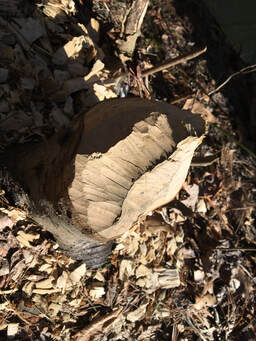 What a lovely reminder of the “hidden” work that is happening all around us. If we hadn’t decided to change our walking routine we wouldn’t have seen it. If we hadn’t have been curious when we first saw the dam, would we even have paid attention to the gnawed trees? I don’t think the jogger we passed with his headphones on saw them. I am so grateful to everyone out there, human or not, who are so passionate about what they do, that they are driven to share it with others. To the Zoom meetings and workshops. To all those gleaming white wood chips lying on the forest floor. At last, my first radio story with West Virginia Public Broadcasting's Inside Appalachia. Inside Appalachia is a fascinating show all about the art, community and culture of this often misunderstood part of the world. I have learned so much about Appalachia listening to it over the years and am thrilled to be part of their team.
You can read or listen to my story about the Waldensian winemakers of Valdese, NC here. 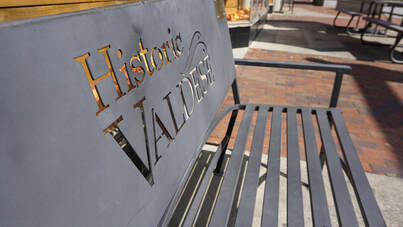 I’ve been working on a radio story for Inside Appalachia about the Waldensian winemaking tradition in Valdese, NC. The story is a kind of homecoming for me. I had the pleasure of recording an oral history interview about this very tradition when I was the oral historian for the Friends of Mountain History exhibit, That’s A Long Row to Hoe, funded by a Blue Ridge National Heritage grant. If you have never been there, Valdese North Carolina is a charming little town, nestled between Morganton and Hickory NC, and chocked full of history. It was a delight to return. 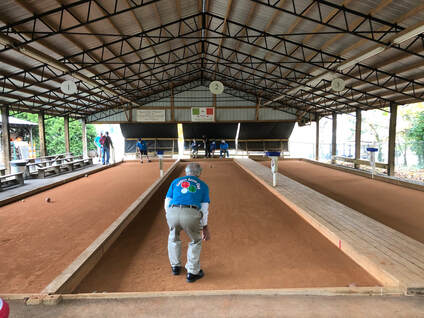
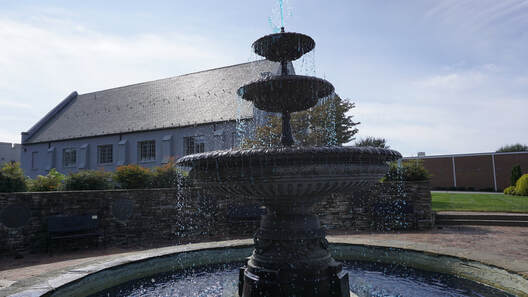 Next stop was the Waldensian Heritage Museum, which examines the 700 years of history before the Waldenses migrated to North Carolina, as well as the Waldensian history and culture of those who helped settle Valdese. Executive Director Gretchen Costner sat down with me (at a safe distanced) in the museum’s library and tried to consolidate this fascinating story. The Waldensians were persecuted for hundreds of years in Europe for their heretical beliefs, including the belief that people should be able to read the Bible for themselves.  Interestingly enough, it was the end of their persecution and subsequent return to their homelands in Italy that prompted their need to immigrate to the U.S. Once they were able to settle down and farm they began to run out of land. A colony of Waldensians first came to Burke County, North Carolina in 1893. They brought with them all sorts of food customs including bread baking, sausage making and the production of wine. 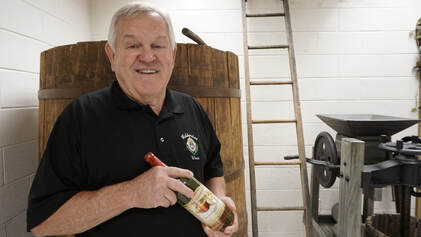 Finally, I interviewed Eddie Zimmerman, owner of the Waldnesian Style Winery, who led me on a tour through the museum and talked about traditional Waldensian winemaking traditions. I loved hearing about the parts of the winemaking process they brought over from Italy, and seeing the tools used by Valdese’s winemakers.  Another “character” in the story is Freddy Leger, one of the founders of the Waldensian Heritage Winery and the man I interviewed 11 years ago. When I started making calls about the story I discovered that Freddy had died only a week before. It took some digging but I finally got my hands on a copy of the interview I had conducted so many years ago at the winery. What a gift to hear his voice. And what a lesson about the importance of archives. If it hadn’t been for the Waldensian Heritage Museum, Freddy’s story would have been lost. You can hear more about the Waldensian winemaking tradition when the story is aired on Inside Appalachia, on West Virginia Public Broadcasting. I’ll post the link here when it is on the air. Thrilled to be selected as part of the new Folkways Reporting Corps at Inside Appalachia, a radio show produced by West Virginia Public Radio. I've always been a huge Public Radio fan and was originally interested in studying audio when I first went to the Center for Documentary Studies at Duke. Being part of the Inside Appalachia folkways reporting team means that I get to combine several loves, storytelling, Appalachia and history!
Inside Appalachia Announces Second-Year Folkways Corps West Virginia Public Broadcasting | By Lalena Price West Virginia Public Broadcasting has selected 13 storytellers to be a part of the second year of its Inside Appalachia Folkways Reporting Project. The project expands the reporting of the Inside Appalachia team to include more stories from West Virginia, as well as expanding coverage in Virginia, Kentucky, Tennessee, North Carolina and Ohio. Storytellers will explore Appalachia’s rich folklife, arts and material culture. There are seven new corps members from across central Appalachia including Brian Koscho, Rebecca Williams, Connie Bailey, Caitlin Myers, Clara Haizlett, Trevor McKenzie and Kelley Libby. Six corps members are returning from last year including Mason Adams, Heather Niday, Lexi Browning, Rachel Greene, Zack Harold and Nicole Musgrave. Inside Appalachia producer Roxy Todd said competition for the positions was fierce. “We had more than 50 applicants to choose from so, this was a difficult choice for us to make,” Todd said. “Each of the reporters we selected brings something unique and creative to the project.” The 2020-2021 Folkways Reporting Corps members are Mason Adams of Floyd County, Va., was born in Clifton Forge and has covered Blue Ridge and Appalachian communities since 2001. Adams shifted from a career as a biologist to become a reporter in 2001 through an internship at High County News in Paonia, Colo. From 2003-2012, he wrote for The Roanoke Times, in Roanoke, Va., and has pursued freelance opportunities for a variety of outlets, including The New Republic, Politico Magazine, Yes! Magazine, Virginia Mercury, Blue Ridge Outdoors, 100 Days in Appalachia, Vice, Belt Magazine and others. With a path in journalism shaped by her story-telling veterinarian father, Connie Bailey-Kitts of Bluefield, Va., left her home to study journalism at Iowa State University, then worked as a science journalist before returning to her native southwest Virginia for a life-altering period as a caregiver. Coming home also meant a rediscovery of Appalachia and the chance to write about its people, places and problems while reporting for a weekly newspaper and freelance writing and editing. Rachel Greene is a freelance journalist based in Durham, N.C. A 2018 graduate of the UNC School of Media and Journalism, Greene’s work focuses on environmental issues and folkways throughout Appalachia and the South. Clara Haizlett of Bethany, W.Va., is a recent graduate of West Virginia University and producer of Sandstone Podcast. She is a multimedia storyteller inspired by folklife, cross-cultural dialogue and the natural world. Zack Harold of Ashford, W.Va., is a southern West Virginia native, the grandson of two coal miners, the son of a Pentecostal preacher, a former staff writer with the Charleston Daily Mail, and former managing editor of WV Living and Wonderful West Virginia magazines. He currently works with WVU Extension. He enjoys playing music with his band The Sycomores. Brian Koscho is from Athens, Ohio. He moved there in 2001 to attend Ohio University after growing up in the Rust Belt city of Lorain, Ohio. He is currently back in school, as a graduate student seeking an MFA in Communication Media Arts from Ohio University focusing on Audio Storytelling, Publication Design and regional history. He spent 12 years as the marketing director for Stuart’s Opera House and the Nelsonville Music Festival in Nelsonville, Ohio. Kelley Libby is a radio producer based in Charlottesville, Va. Her work has been heard on NPR’s All Things Considered, BackStory, With Good Reason, Re:sound and Inside Appalachia. She enjoys traveling, listening to stories and documenting the excellence and diversity of Virginia through its folkways. Trevor McKenzie lives in Deep Gap, N.C., where he works with manuscripts, field recordings, and other materials detailing Appalachian history and life in the W.L. Eury Appalachian Collection at Appalachian State University. On nights and weekends, he performs traditional music at square dances and concerts both as a solo artist and with various string bands. Nicole Musgrave of Whitesburg, Ky., has a Master of Arts degree in Folk Studies from Western Kentucky University and works as a public folklorist and media producer in southeast Kentucky. She currently serves as the Folklife Specialist at Hindman Settlement School, developing and implementing arts- and folklife-based programming in public schools. Caitlin Myers is a writer, environmental educator, and amateur water scientist. She splits her time living in both Knoxville, Tenn., and Whitesburg, Ky., She's covered southern politics, social movements, and environmental justice issues with Scalawag, Science for the People, Current Affairs, Commune Magazine and others. She is a recipient of the Kristi Havens Fellowship through Sundress Academy for the Arts. Heather Niday of Green Bank, W.Va., is the program director for Allegheny Mountain Radio. She began as a volunteer deejay in 1998 and joined the AMR staff in 2007 as news director and became program director in 2013. Heather is a long-time musician (flute and vocal), choir director for Arbovale United Methodist Church. She and her husband co-host "Something Different," a weekly show on AMR. Rebecca Williams of Swannanoa, N.C., is a writer, director, educator and digital media storyteller who has facilitated community-based arts and cultural development projects for the past 25 years in Virginia, Florida, Kentucky, Oklahoma and North Carolina. Along with her husband, Jerald Pope, she co-founded Serpent Child Productions, a nonprofit dedicated to the collaborative creation of multidisciplinary art that draws on the history and stories of community participants. Rebecca is a graduate of Duke University’s Center for Documentary Studies. Well it feels odd to try to write about anything other than the world pandemic that is upon us at this time. Not so much in Western North Carolina (yet) as other parts of the U.S. and the world. I've discovered NPR's Tiny desk concerts in my "shelter at home" time. Am listening to the soulful and soothing work of Max Richter as I write.
Funny the things that come into focus at a time like this. How I've been talking to people I haven't connected with in awhile- both family and friends. How much the bird song and spring wildflowers mean to me. How the sound of that cello and violin reaches into my body and offers me something that I didn't even know I needed. I've been thinking a lot about our stories. Who is collecting the stories from this pandemic? Where is a vessel wide enough, deep enough to hold them all? The stories of loss, of grief, of rage, and fear. The stories of resilience and courage and community. I suspect that we are the vessels my friends. That one of our jobs now is to open our hearts wide enough to let the stories in. Through our phone calls, our instagram posts, our long discussions on Facebook, our socially distanced greetings to the neighbors across the street. May we draw strength from the art and the stories that deeply connect us to each other and ourselves. 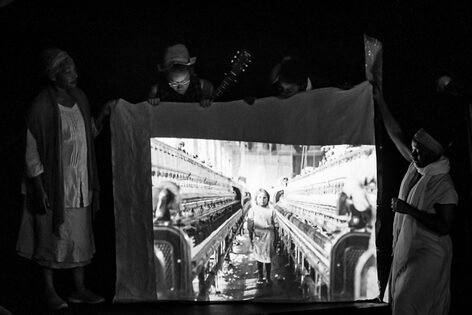 We aren't far past the first week of the year but already it feels like some of the shine is off of 2020. I’ve decided it’s not too late to look back at 2019 and reflect on what happened and where I want to go with Mountain Girl Media in this relatively new year. My initial response to this question was a panicked - wait a minute, what did I do? I tried making a list of projects but that felt tired and uninspired. So I turned to one of my favorite creative tools- colored markers and brainstorming . And voila. A web of some of my favorite projects from 2019. In fact it was a year filled with stories and art. Although traditional video production took a back seat to other ways of working with images and stories, I realize that it’s all fueled by my unshakeable belief in the power of storytelling. Here are some highlights. Video Design and Artist Residency with Asheville Creative Arts. I got the chance to work once again with Abby Felder of Asheville Creative Arts creating the video design for The Warp and The Weft. Blending puppetry, video, archival photographs, music, and storytelling, this original production explores the history of child labor, the evolving concept of childhood and the power that comes from controlling one’s own narrative. In addition to video design I worked with middle and high school youth from the community groups VAMOS and MANOS, to co- facilitate a storytelling workshop with Edwin Salas Acosta where youth told their own stories These stories about self identity were incorporated into the the show. As has been true for many years now, much of my free time has been spent working on Blanket Town, the documentary film I am making about Swannanoa and the Beacon Blanket Mill. In 2019 I was invited to present excerpts of the film at the Frank and Jane Garboe folklife center and collaborate with the Swannanoa Valley Museum and History Center on it’s exhibit about the Beacon blanket mill and its impact on the Swannanoa Valley. A sequence from the film depicting the devastating fire and residents responses to it, was featured in the exhibit. 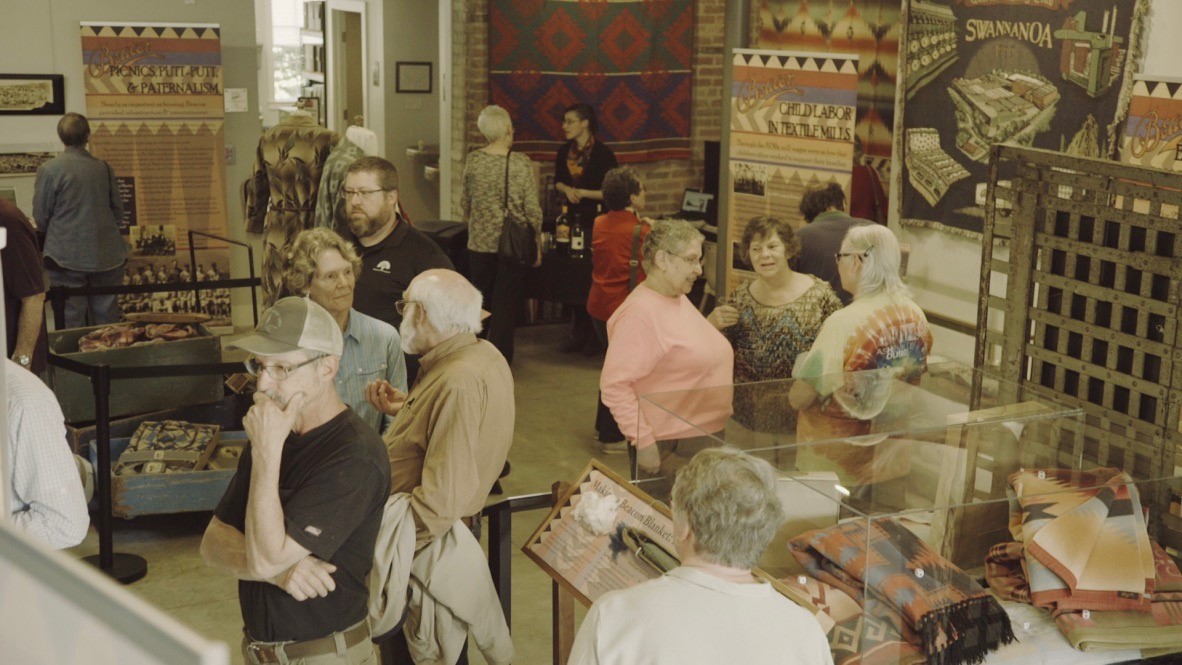 I also gave a presentation bout the migration of the textile industry to the south. to a standing room only crowd at the museum's inaugural History Cafe in April. But one of my favorite projects was working on a Digital Storytelling project with Norma Duran Brown, Mujer a Mujere, MANOS and VAMOS and Middle and High school youth at Erwin school district. Working after school for 2 months, the youth wrote, shot and edited personal digital stories on their laptops and phones. Although the youth's digital stories. centered on loss, change and resilience, are private, this short video (made on my phone) explains the project's process and outcomes. 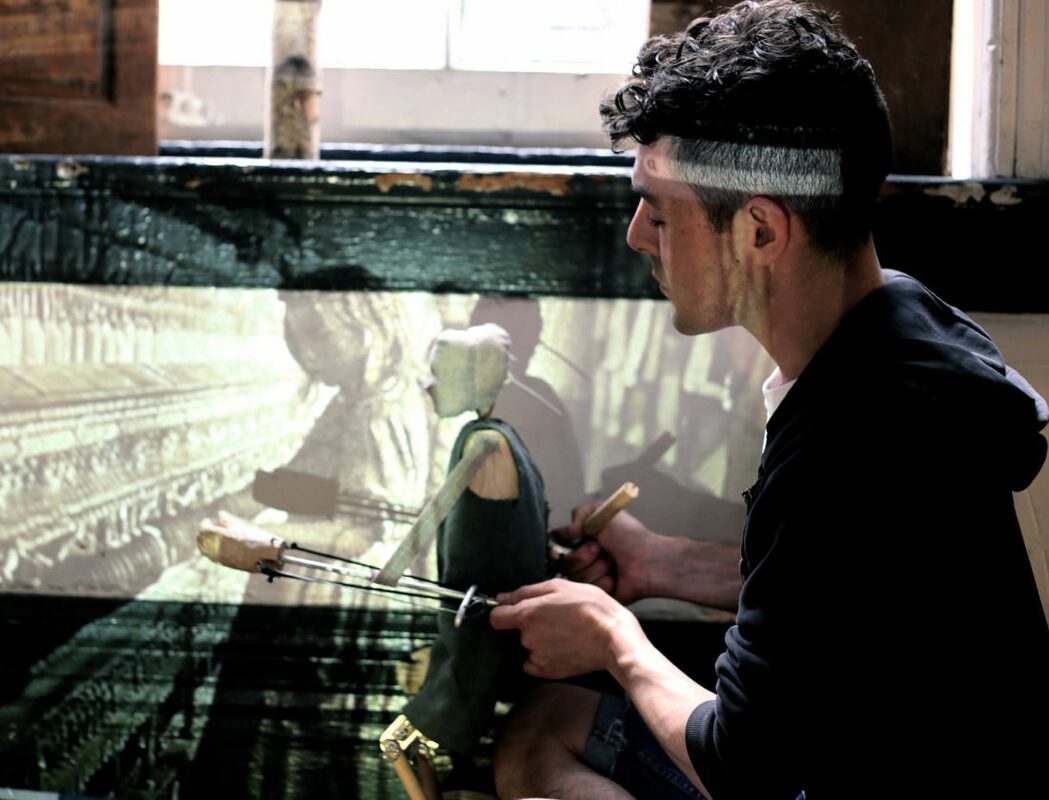 Puppeteer Anthony Napoletano works before a projected image of a young textile mill worker from the early part of the 20th century. Photo by Silvia Forn So happy to be working with Asheville Creative Arts' again, designing video for their new multi-media performance, The Warp & the Weft. ACA's director, Abby Felder told me about her efforts with this piece years ago. Big themes, dreamlike movement, oral history, puppets, and deep storytelling. What's not to love ? Its been exciting to watch Warp & Weft evolve and dig into some of my textile town B-roll to create part of the video landscape for this play. Big thanks to Mountain Xpress for the terrific article about the upcoming production. ____________________________________________________________________________________________________________________Mountain Xpress Asheville Creative Arts debuts its latest original production Posted on March 21, 2019 by Thomas Calder There is plenty to unpack in Asheville Creative Arts’ latest original production, The Warp & The Weft. The professional children’s theater group will debut the hourlong performance on Friday, April 19, at The Magnetic Theatre. Combining puppetry, live folk music, video and storytelling, the piece explores the history of child labor, the evolving concept of childhood and the power that comes from controlling one’s own narrative. It runs through Sunday, April 28. Though the show’s development technically began two years ago, its director, Abby Felder, says the idea dates much further back. “The whole thing began when I was in the fourth grade,” she explains. At the time, her class was studying Lewis Hine, an early 20th-century investigative photographer, who documented child labor in America. Among Hine’s many subjects were those working in the textile mills in North Carolina. The images of these children, says Felder, who was raised in Charlotte, led to an early epiphany. “They were my same age but clearly grew up in incredibly different circumstances,” she says. “I think that was the first moment, as a young person, where I started to think about the concept of childhood.” The resulting multimedia production incorporates video of Hine’s images, as well as historical audio recordings of former child textile workers, originally gathered by UNC Chapel Hill. In juxtaposing Hine’s visual stories with the audio accounts, The Warp & The Weft seeks to show its young audience members how narratives are shaped, depending upon who is telling the story. The piece also brings in excerpts from present-day interviews with local students from Hanger Hall School for Girls, as well as members of the Mentoring and Nurturing Our Students program, which works with newly immigrated Latinx students. Both groups provide perspectives on contemporary childhood, particularly as it pertains to recently displaced youths. Too often, says Rebecca Williams, the show’s videographer, “there are lots of important voices that are missing from our narratives.” These absences, she notes, are evident in Hine’s historical work, which centered on predominantly white children. A more inclusive production is not only a focus for The Warp & The Weft but ACA’s overall goal. In 2016, Daniele Martin came on as the theater group’s community outreach and engagement coordinator. Since that time, she’s been developing relationships with marginalized and rural communities. In addition to her work offstage, Martin sought to enlist more performers and artists of color onstage. The group’s forthcoming production, she says, highlights this effort. Of The Warp & The Weft’s six cast members, four are people of color, including Martin. Along with greater diversity, the upcoming production also embodies a larger trend in the theater group’s future direction. “We’re trying to shift more toward original work,” Felder explains. Moving forward, works by ACA’s regular contributing artists, as well as interested community members who participate in the organization’s incubator series, will take precedence. In the meantime, the group continues to perform family classics, including this summer’s production of Charlotte’s Web. Set to run July 18-28, the familiar tale follows Wilbur the livestock pig and his friendship with the titular spider. The popularity of the story, says Felder, makes it “really ripe for some magical reimagining in terms of presentation.” This will include audience participation as well as live bluegrass music. Further, Felder notes, the group is discussing the use of wooden and found-object puppetry for Wilbur and the story’s additional cast of barnyard animals. Both The Warp & The Weft and Charlotte’s Web highlight ACA’s ongoing interest in expanding the boundaries of traditional storytelling and stage production methods. Throughout the organization’s seven-year history, Felder notes, “we’ve found that young people are an incredibly sophisticated audience … able to absorb and experience very complex things, and so we try and just push the envelope a little bit.” The Warp & The Weft also makes explicit that in order to truly expand, multiple perspectives must be encouraged and invited to share in the experience, both onstage and off. This, says Felder and fellow cast members, makes ACA’s mission something that will hopefully resonate long after the curtain is drawn. “I feel like theater is a very profound medium in terms of allowing young people to hold witness, but then to also experience, feel and practice things like empathy and critical thinking,” Felder says. Williams agrees, adding that the group’s commitment to audience participation emphasizes the connection and importance of narrative. “I think there is a real value in people understanding that the act of telling their own story is a really empowering and affirming action,” she says. “It’s important to see how your story plugs into that larger story, the community story.” WHAT: The Warp & The Weft WHERE: The Magnetic Theatre, 375 Depot St., avl.mx/5sq WHEN: Opening night is Friday, April 19, at 7 p.m. The show runs through Sunday, April 28. Times vary. Discounted school and camp matinee performances are also available. $23 adults/$12 students About Thomas Calder Thomas Calder received his MFA in Fiction from the University of Houston's Creative Writing Program. He has worked with several publications, including Gulf Coast and the Collagist. I know its mid-August but I am stubbornly clinging to the illusion that there is still time to do some of those fun summer projects that have been on my to do list. And one of those has to do with kicking back and listening to stories. Whether you are taking one more road trip, hanging out in a hammock in your backyard, or just looking for something new to listen to during your daily commute, now is the perfect time to check out some new story offerings.
A great place to start is the California Foodways podcast, reported and produced by award winning public radio journalist, Lisa Morehouse. Reported from every county in the state, California Foodways is a fascinating dive into food as our common language “ that lets us explore culture, history, economics, the environment, and everything that goes into making the California story.” You can subscribe to the podcast here. One of the joys of summer is the chance to do regular things outdoors- picnics, concerts, and...audio? Founded by graduates of Duke's Center for Documentary Studies, Audio Under the Stars, is summer-long outdoor audio festival, where hundreds of people come to lie on blankets, eat food and drink wine, and listen to a curated offering of audio stories. If you are in the Durham area, there is one more chance to hang out on the lawn under the twinkle lights this summer, on Friday August 24th. Or you could get some of your own friends together, sit outside and listen to some of the stories here. Of course, if you want to watch as well as listen to stories you can hardly go wrong watching some of the digital stories from StoryCenter- an organization that uses storytelling and participatory media for reflection, education, and social change. A leader in the digital storytelling movement, StoryCenter, partners with organizations and individuals to create autobiographical digital stories based on people’s lived experience, which often include voices that are underrepresented in mainstream media. You can peruse many of their stories here. May your last days of the season be anchored in sweet summer stories. |
NEWS ARCHIVES
July 2021
|
